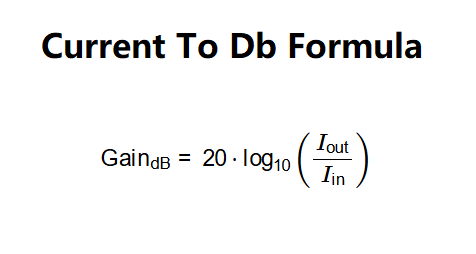 Home
Home
 Back
Back

Definition: This calculator computes the decibel gain (Gain_dB) based on the ratio of output current to input current.
Purpose: It is used in audio engineering, telecommunications, and electronics to measure the amplification or attenuation of a signal in systems where current is the primary concern and impedances are matched.
Decibel gain is calculated using:
Current conversions:
Explanation: Input and output currents are converted to amperes, then the ratio \(I_{\text{out}} / I_{\text{in}}\) is computed, and the result is scaled using the logarithmic formula to get the gain in decibels. The factor 20 is used because the decibel calculation for current ratios squares the ratio (power is proportional to current squared), so \(20 \cdot \log_{10}(I_{\text{out}}/I_{\text{in}}) = 10 \cdot \log_{10}((I_{\text{out}}/I_{\text{in}})^2)\).
Details: Decibel gain based on current is crucial for understanding signal amplification in amplifiers, audio systems, and communication devices, especially when impedances are matched or not a factor, ensuring accurate system design and performance.
Tips: Enter the output current (I_out) and input current (I_in) in A, mA, or µA (I_in must be greater than 0). The result will be the decibel gain (Gain_dB).
Q: What does a negative dB value mean?
A: A negative dB value indicates attenuation, meaning the output current is less than the input current, resulting in a power loss. For example, a Gain_dB of -6 dB means the output current is half of the input current.
Q: Why is I_in not allowed to be zero?
A: The formula involves dividing by I_in, and division by zero is undefined in mathematics. A zero value would make the logarithmic calculation invalid.
Q: Can I use this calculator for voltage instead of current?
A: No, this calculator is designed for current ratios. For voltage, the formula is similar, \( \text{Gain}_{\text{dB}} = 20 \cdot \log_{10}\left(\frac{V_{\text{out}}}{V_{\text{in}}}\right) \) (if impedances are matched), but requires a different calculator.
Q: What is the significance of the factor 20 in the formula?
A: The factor 20 is used because decibels for current ratios account for the fact that power is proportional to the square of current. Thus, \(20 \cdot \log_{10}(I_{\text{out}}/I_{\text{in}}) = 10 \cdot \log_{10}((I_{\text{out}}/I_{\text{in}})^2)\), aligning with the power-based decibel definition.
Q: How do I interpret a Gain_dB of 6 dB?
A: A Gain_dB of 6 dB means the output current is approximately double the input current. Conversely, -6 dB means the output current is approximately half the input current.